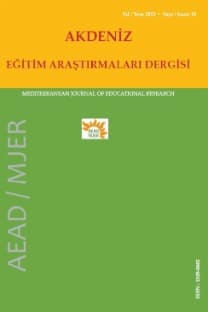Dimensions of Multicultural Education: Pedagogical Practices Knowledge of Graduate Students Towards Multicultural Education in Turkey
Çokkültürlü Eğitimin Boyutları: Türkiye’de Çokkültürlü Eğitim Konusunda Lisansüstü Öğrencilerin Pedagojik Uygulama Bilgisi
___
Aydın, H. & Tonbuloğlu, B. (2014). Graduate students’ perceptions on multicultural education: a qualitative case study. Eurasian Journal of Educational Research, 57, 29-50.Banks, J. A, & Banks, C. A. McGee. (2010). Multicultural education: issues and perspectives. 7th ed. Hoboken, N.J.: Wiley.
Banks, J. A. (1993a). Multicultural education: Historical development, dimensions, and practice. Review of Research in Education, 19, 3-49.
Banks, J. A. (1993b). The canon debate, knowledge construction, and multicultural education. Educational researcher, 22(5), 4-14.
Banks, J. A. (2008). An introduction to multicultural education. 4th ed. Boston: Pearson/Allyn and Bacon.
Banks, J.A. (2002). Series foreword. In M. Vavrus (Ed.), Transforming the multicultural education of teachers: Theory, research and practice (pp.vii-ix). New York, NY: Teachers College Press.
Braun, V. and Clarke, V. (2006). Using thematic analysis in psychology. Qualitative Research in Psychology, 3(2), pp.77-101.
Camicia, S. P. (2007). Prejudice reduction through multicultural education: Connecting multiple literatures. Social Studies Research and Practice, 2(2), 219-227.
Chisholm, I. M. (1994). Preparing teachers for multicultural classrooms. The Journal of Educational Issues of Language Minority Students, 14(1), 43-68.
Creswell, J. W. (2007). Qualitative inquiry & research design: choosing among five approaches. 2nd ed. Thousand Oaks: Sage Publications.
Demircioğlu, E., & Özdemir, M. (2014). Pedagojik formasyon öğrencilerinin çok kültürlü eğitime yönelik tutumlarının bazı değişkenlere göre incelenmesi [Analysis of pedagogical formation students’ attitudes toward multicultural education]. Ege Eğitim Dergisi, 15(1), 211-232.
Engin, G., & Genç, S. Z. (2015). Attitudes teacher candidates towards multicultural education (Canakkale Onsekiz Mart University Example). Route Educational and Social Science Journal, 2(2), 30-39.
Finch, J. T. (2008). Perceptions of preservice and in-service teachers working toward culturally responsive teaching: A study of a multicultural education graduate course at an urban university (Order No. 3308343). Available from ProQuest Dissertations & Theses Global. (304564280). Retrieved from http://ezproxy.lib.indiana.edu/login?url=http://search.proquest.com/docview/304564280?accountid= 11620
Gay, G. (2010). Culturally responsive teaching: theory, research, and practice. 2nd ed. New York: Teachers College Press.
Karataş, S. (2015). Teachers’ views on multicultural education: Sample of Antalya. Anthropologist, 19(2), 373-380.
Katz, A. (1999). Keepin' it real: Personalizing school experiences for diverse learners to create harmony and minimize interethnic conflict. The Journal of Negro Education, 68(4), 496-510.
Merriam, S. B. (2009). Qualitative research: a guide to design and implementation. San Francisco: JosseyBass.
Riedler, M. & Eryaman, M.Y. (2016). Complexity, Diversity and Ambiguity in Teaching and Teacher Education: Practical Wisdom, Pedagogical Fitness and Tact of Teaching. International Journal of Progressive Education, 12(3), 172-188.
Riehl, C. (2008). The principal's role in creating inclusive schools for diverse students: A review of normative, empirical, and critical literature on the practice of educational administration. The Journal of Education, 189(1/2), 183-197.
Tucker, G. R. (1998). A global perspective on multilingualism and multilingual education. Multilingual Matters, 3-15.
Yin, R.(1994). Case study research: design and methods. Thousand Oaks, CA: Sage Publishing. Zeichner, K.M., &National Center for Research on Teacher Learning, E.M. (1993). Educating Teachers for Cultural Diversity. NCRTL Special Report.
Zirkel, S. (2008). The influence of multicultural educational practices on student outcomes and intergroup relations. The Teachers College Record, 110(6), 1147-1181.
- ISSN: 1309-0682
- Yayın Aralığı: 4
- Başlangıç: 2008
- Yayıncı: Tayfun Taşbilek
Ortaokul Matematik Öğretmenlerinin Alan Ölçme Konusundaki Anlamalarının İncelenmesi
S. KOZA ÇİFTÇİ, İ. Elif YETKİN ÖZDEMİR
Küresel Vatandaşlık Ölçeğinin Türkçeye Uyarlama Çalışması
Resimli Çocuk Kitaplarının Toplumsal Cinsiyet Rolleri Açısından İncelenmesi
PINAR BAĞÇELİ KAHRAMAN, Habibe ÖZDEMİR
Gülgün BANGİR ALPAN, ÖZDEN DEMİRKAN, Gürcü KOÇ ERDAMAR, NEVRİYE YAZÇAYIR, GÜLÇİN KEZBAN SARAÇOĞLU
Ortaokul Öğrencilerinde Öz-Yeterlik ile Anksiyete ve Depresyon Arasındaki İlişki
Türkiye'de Kimya Eğitimi Alanında Yapılan Lisansüstü Çalışmalar
Ortaokul Matematik Öğretmenlerinin Yazılı Sınav Sorularının İncelenmesi
Yunus Emre İle İlgili Araştırmaların Bibliyometrik Analizi
